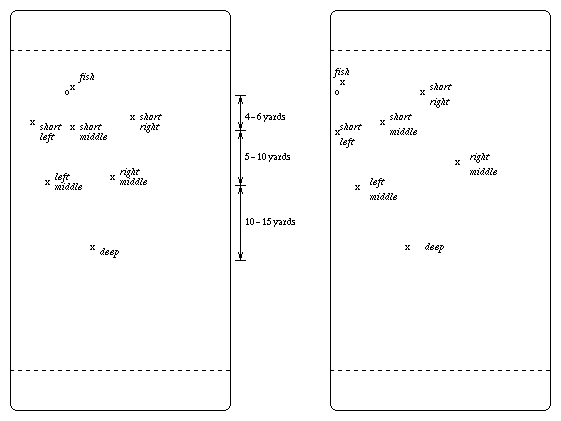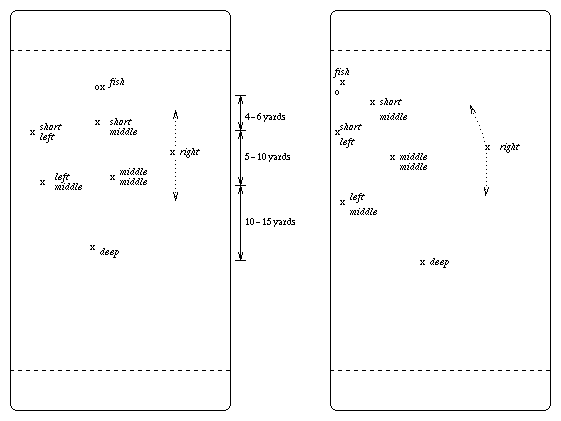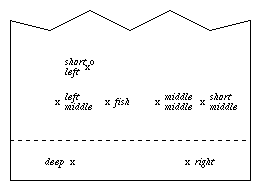Would you like to make this site your homepage? It's fast and easy...
Yes, Please make this my home page!
Salmon Zone
I first experienced this type of zone playing against Sockeye. It was
quite a gruesome experience. The UBC team also used a modified version
of this which seemed to suit all of us quite well (at least it was
better than the clam for us :). In honour of Sockeye, I call the
person who chases and marks the disc the fish. (This zone has
also been called a 1-3-2-1 zone, a 1-3-3 zone, or a rabbit zone not
to be confused with our other rabbit zone.)
This zone is particularly devastating when the trap is set up
as shown in the figure on the right. Thus, one of the goals of this
zone is to force the disc to the sideline without giving up to much
ground. If there's any kind of cross wind, then the fish should
force the disc towards the sideline that is in the downwind direction.
This makes getting the disc out of the trap situation even harder.

- Non-trap set (shown on the left)
- The fish is responsible for forcing the disc towards
one side of the field. The fish is the only player that
marks the disc. Depending on the situation, the fish
might also want to try to take away a backwards pass.
- The short middle is the most important position. This
person has to be aware of all cuts through the center
and at the same time break up any give and go opportunities.
- The short on the strong-side of the field can back up
a little bit to sucker the disc towards the sideline which
we want to trap. The short on the other side of the field
needs to watch out for any I/0 throws and be ready to
prevent any swings if a dump occurs.
- The middles prevent any hammers and pretty much play man
defense for people in their zone.
- The deep does the usual barking and minding of deep threats.
- Trap set (shown on the right)
- Once the disc gets on the sideline the fish will move
to deny the dump. The short middle
will move to cut off a swing. The short on that
side will move up a bit to prevent an easy pass down the
line. These three players are basically like a cup in
a standard zone.
- The weak-side middle (the right middle in the case shown
in the figure) must hurry over to protect against any throws
through the cup.
- The strong-side middle (the left middle in the case shown
in the figure) backs up down the sideline weary of any big
bending throws down the sideline.
- The weak-side short (the short right shown in the figure)
has the most ground to cover. However, since these are
long throws, probably into the wind, this person has a bit
of time to get to an ambitious swing or cross field hammer.
Depending on the offensive players' set up, the deep might
be able to help on that long cross field hammer, too.
Note: strong-side = same side of the field that the disc is on.
weak-side = opposite-side of the field that the disc is on.
After playing this zone almost exclusively now with my league
team La Guarapachanga in the summer of 1997,
we've come up with a slight
variation. The idea is the same -- force the other team into a trap
situation, but the set-up is slightly altered as shown in the figure
below.
 The main difference is that the person playing the weak-side position
has a lot of flexibility and can either play up or back depending on
the situation and how the other team has been beating you. It also
puts a permanant player in the middle of the field, the middle-middle.
This person now becomes responsible for positioning and communcicating
with the short middle which is also very important. The final twist
is that the short-middle will mark the disc and take away the dump in
the trap set. The fish then cuts off the swing pass. This has the
added advantage of giving the fish a bit of a break and making it
easier for the fish to mark the disc once the other team gets out of
the trap situation.
The main difference is that the person playing the weak-side position
has a lot of flexibility and can either play up or back depending on
the situation and how the other team has been beating you. It also
puts a permanant player in the middle of the field, the middle-middle.
This person now becomes responsible for positioning and communcicating
with the short middle which is also very important. The final twist
is that the short-middle will mark the disc and take away the dump in
the trap set. The fish then cuts off the swing pass. This has the
added advantage of giving the fish a bit of a break and making it
easier for the fish to mark the disc once the other team gets out of
the trap situation.
Endzone Set
When the disc gets to close to the endzone, the regular salmon
set-up is not necessarily
the best, because it does not collapse very nicely in the short space.
However, without to much trouble, the zone can be reconfigured
as follows:

It's not really important where everyone lines up in the line of four.
The important thing is to have the right (or weak-side player) take one
back corner and the deep take the other. This is done because next to
the deep, the weak-side player should be able to cover the most ground
and read plays the best. The line of four listens to the people behind
them for directions. The player on the disc will mark the disc back
towards the middle of the field. When the disc gets moved, the marker
and the four defenders in a line will rotate much like the
wall zone. When leaving the wall to mark the disc, it is important
to approach the disc cautiously, trying not to allow the thrower to throw
to the space you just vacated, because the wall will need a few seconds
to adjust.
This is still in its experimental stage, but I have played on teams
where we have done a wall 1-4-2 set all the way down the field with
much success.
previous |
index |
next


